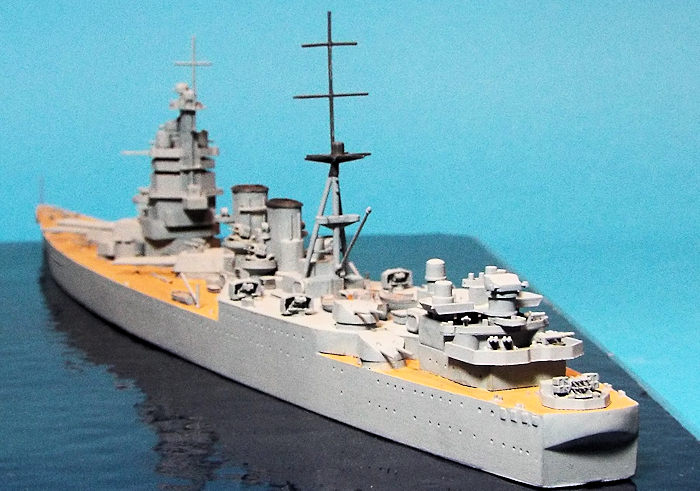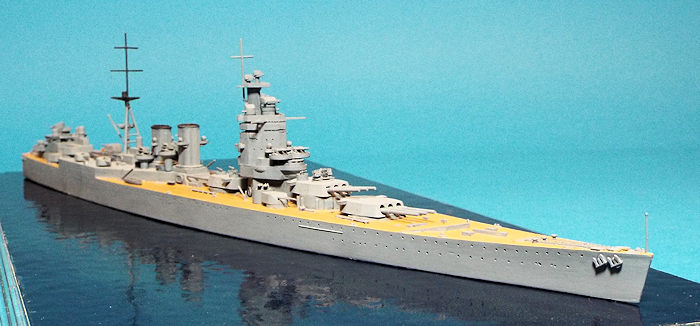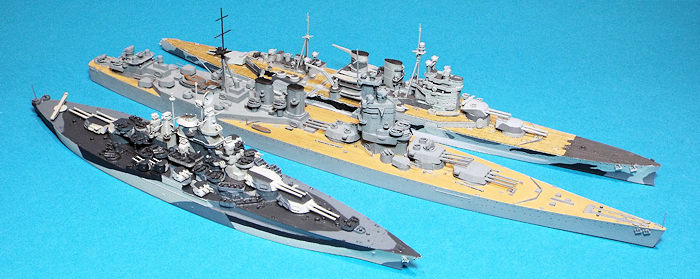
Imperial Hobby Productions 1/700 G3 Battlecruiser
| KIT #: | 270008 |
| PRICE: | $59.95 |
| DECALS: | None |
| REVIEWER: | Dale Rannals |
| NOTES: | Additional Bits: 1/700 Tamiya Nelson, 3D Model Parts 2-pounder Pom-poms, Niko Models 4.7” twin turrets |

| HISTORY |
The
Alternate History:
HMS Invincible was always a busy girl. Soon after completion, she was
constantly in and out of the dockyard; mostly to iron out all the bugs in
the new 16” turrets. Once these and a few propulsion plant vibration issues
were solved, she became the proud flagship of the battlecruiser fleet. After
a few show-the-flag cruises, she returned to John Brown on the Clydesbank
for a mid 1930’s refit. The well worn propulsion plant was renovated, her
four single 4.7” anti-aircraft guns replaced by four twin units with
accompanying high angle directors. An additional pair of 40mm pom-poms were
fitted, along with several .5” machine guns. She patrolled with HMS Hood
during the Spanish civil war and was in dockyard hands for a slight update,
mostly radar installations, when World War 2 broke out. After searching for
German surface raiders in the South Atlantic, she joined Admiral
Cunningham’s Force H in the Mediterranean. It was an active period involving
many Malta resupply runs. On these she was usually detached, with HMS
Renown, to interdiction and harass the
 Italian
Navy; unfortunately, no decisive engagements offered … the Italians being
very cautious and reluctant to commit their forces. In May of ‘41, the
German battleship Bismarck sunk HMS Hood. Hood was an old lady, but she was
still “The Lady”, and this German victory resulted in a mad scramble of
British forces to hunt her down. Invincible and Renown, again sent ahead of
Force H, managed to intercept the battleship and cruiser Prinz Eugen just
outside of German air cover and send them to the bottom. Back with the Home
Fleet, the next year was of little activity, lying in wait against the
possible sorties of German heavy units from Norway. Once new units of the
Lion class became available, Invincible sped across the Atlantic for a refit
in the USA. Here she got eight US pattern quad 40mm Bofors, along with
numerous 20mm single mounts. The last two years of the war was spent with
her wartime partner Renown, raiding across the Indian ocean and bombarding
the Japanese home islands. She was in Tokyo bay for the Japanese surrender.
Thoroughly worn out by seven years of war, HMS Invincible was sold for
breaking up in 1949.
Italian
Navy; unfortunately, no decisive engagements offered … the Italians being
very cautious and reluctant to commit their forces. In May of ‘41, the
German battleship Bismarck sunk HMS Hood. Hood was an old lady, but she was
still “The Lady”, and this German victory resulted in a mad scramble of
British forces to hunt her down. Invincible and Renown, again sent ahead of
Force H, managed to intercept the battleship and cruiser Prinz Eugen just
outside of German air cover and send them to the bottom. Back with the Home
Fleet, the next year was of little activity, lying in wait against the
possible sorties of German heavy units from Norway. Once new units of the
Lion class became available, Invincible sped across the Atlantic for a refit
in the USA. Here she got eight US pattern quad 40mm Bofors, along with
numerous 20mm single mounts. The last two years of the war was spent with
her wartime partner Renown, raiding across the Indian ocean and bombarding
the Japanese home islands. She was in Tokyo bay for the Japanese surrender.
Thoroughly worn out by seven years of war, HMS Invincible was sold for
breaking up in 1949.
Reality: Towards the end of World War One, the US Navy started an ambitious naval program. Congress authorized the construction of 9 super-ships .. five battleships and four battlecruisers (the first of the type ever designed for the US Navy). The battleships of the South Dakota class were to carry a dozen 16” rifles in four triple turrets on a hull displacing 41000 tons and capable of 23 knots. The battlecruisers were, arguably, even more interesting. On an immense hull 888ft long, the 37000 ton vessels sported eight 16” rifles carried at the very impressive speed of 33 knots. They were, however, rather lightly armored with only an 7 - 8” main belt and a deck of only 2”. The gigantic scout cruisers had a very elegant look to them.
Japan, meanwhile, had started it's own naval construction program. Eight battleships and eight battlecruisers were designed and to be built, like the US ships, to give the their navy a qualitative edge over all others. The first batch were designed for 16” cannons, the last batch (the battleships at least) were to sport 18” guns.
The British, coming out of World War One, were sitting pretty good in numbers of capital ships compared to any other navy. The Grand Fleet had 42 capitol ships on hand. Unfortunately, the numbers didn't tell the whole story. Many of the ships were old, pre-WW1, and were being sold off for scrapping. Another, HMS Canada, was being sold back to Chile (having been building in British shipyards and then purchased from from Chile on the outbreak of WW1). It was in this atmosphere that the British became aware of the shipbuilding programs of the US and Japan. Not to be left behind in the technology race, they began designing the ships to outclass the ships being designed to outclass all others.
 Several
designs were drawn up for each of the battlecruiser (labeled K thru G) and
battleship (labeled L thru N).
The final designs ended up being similar in appearance, with two
turrets forward and one aft of the tower-style bridge.
This somewhat odd arrangement was chosen to reduce the length of the
armored citadel required to protect the magazines. The final battleship
sported 9 -18” rifles moving at 23kts. But it was the final battlecruiser
design, labeled G3, that really shined. Here, E.L. Atwood and Stanley
Goodall designed the most powerful British capital ship ever. A fine hull
856ft long housed nine 16” cannon, and 160000shp moved her along at 32kts.
Armor was developed under the “all or nothing” scheme developed by the US in
the Nevada class. This eschewed armor everywhere, and instead concentrated
on having the maximum armor possible where it mattered. In this case the
armor belt, carried internal to the hull, was 14” while the deck over the
magazines was 8” thick. This vessel would have been comparable to anything
built by any nation 20 years later.
Several
designs were drawn up for each of the battlecruiser (labeled K thru G) and
battleship (labeled L thru N).
The final designs ended up being similar in appearance, with two
turrets forward and one aft of the tower-style bridge.
This somewhat odd arrangement was chosen to reduce the length of the
armored citadel required to protect the magazines. The final battleship
sported 9 -18” rifles moving at 23kts. But it was the final battlecruiser
design, labeled G3, that really shined. Here, E.L. Atwood and Stanley
Goodall designed the most powerful British capital ship ever. A fine hull
856ft long housed nine 16” cannon, and 160000shp moved her along at 32kts.
Armor was developed under the “all or nothing” scheme developed by the US in
the Nevada class. This eschewed armor everywhere, and instead concentrated
on having the maximum armor possible where it mattered. In this case the
armor belt, carried internal to the hull, was 14” while the deck over the
magazines was 8” thick. This vessel would have been comparable to anything
built by any nation 20 years later.
But it was not to be. The Americans, seeing the new developments across both oceans, now realized their immense monsters then building would be outclassed before they were finished. Also realizing that they had started a new arms race, a very costly one at that, they were quick to try to tame the beast. They called together Britain, Japan, Italy, and France to talk arms reduction. The final outcome, after much delegation, saw Britain accepting parity with the USA as far as tonnage, and Japan agreeing to 60% of that total … a 5-5-3 ratio. Italy and France came out with less, so a 5-5-3-1.75-1.75 ratio in total.
All the new monsters then building, laid down, or designed, were stopped and scrapped. There was to be a 10 year moratorium on new construction, and a 35000 ton size limit after that. There were a couple of exceptions. The USA and Japan were allowed to keep two of the more advanced ships under construction, albeit converted to aircraft carriers. Hence the creation of the carriers Lexington, Saratoga, Akagi, and Kaga. As far as battleships, the USA were allowed to keep the units of the Colorado class, and Japan Nagato and Mutsu … battleships all carrying 16” cannon. As Britain had no such beasts, they were allowed to build two new units with 16” guns, but conforming to the 35000 ton rule.
So in effect the G3's got a new lease on life, but in a highly modified form. The propulsion plant was drastically cut, and weight saving measures were employed to get under the 35000 ton limit. They were, essentially, a 23 knot version of the G3 battlecruisers.
| THE KIT |

So, what you get for your money is a very nicely cast chunk of whitish resin. Detail is very nice. There were a couple very small pinholes on the deck which were easy to cover over with a piece of plastic strip as another small hatch on the deck. Had a little cleanup on the bottom edge to take care of; a few swipes from a sanding stick and all was well.
| CONSTRUCTION |
First thing I did upon receiving
the hull is start looking online for a cheap Nelson or Rodney kit, as one
would be required to complete the kit. I would have taken a Rodney, but as
that is pre-war fit, I wanted a Nelson version which is mid-war fit-out. I
found and ordered an inexpensive Nelson and began looking thru my references
on British battleship load-outs thru the war. I was interested that Nelson
got an outfit of 40mm Bofors in her mid-war refit in the USA. These,
together with the 2 pounder pom-poms, would make for a unique look. The
Nelson kit, made in the early 1970’s, is fairly crude by today's standards,
but the parts I needed, the tower bridge, directors, main and secondary
guns, would all do just fine. One of the things I needed to decide on was
the secondary battery. Nelson had six twin 6” mounts. The G3’s had eight of
these mounts. I didn’t really want to buy another kit just for 2 more
mounts. The other option was to replace all of them with aftermarket resin
or 3D printed items.
 Unfortunately,
that route would cost more than buying another Nelson kit. What saved me is
the mid-war refit in the USA. If I use that “history”, then those two mounts
were landed to make room for two more US 40mm Bofors mounts … and those I
had some spares from a Trumpeter West Virginia kit I was building. Problem
solved.
Unfortunately,
that route would cost more than buying another Nelson kit. What saved me is
the mid-war refit in the USA. If I use that “history”, then those two mounts
were landed to make room for two more US 40mm Bofors mounts … and those I
had some spares from a Trumpeter West Virginia kit I was building. Problem
solved.
The 20mm gun tubs on Nelson's turrets had molded-in single 20mm cannon. I took my trusty Dremel and ground these out. They were replace with single spare guns from a Trumpeter Renown kit. Another issue were those 2-pounder pom-poms. The Nelson units were lacking in detail and I only had one spare (albeit a very nice one from a Trumpeter Renown kit.). So I went looking. I ended up at a website called 3D Model Parts. They have a very nice selection of 1/350 and 1/700 3D printed parts. Among them are very delicate looking pom-poms. The price was good and soon they were in my hands. Amazing detail with barrels so thin I thought they would break painting them. They were (like the single Renown spare) a bit over-sized …. or probably the Nelson pom-poms a bit under-sized, so the assembled mount fits on, instead of into, the Nelson gun tub. Oh well….
So ..superstructure, main, secondary, and AA armament accounted for. What’s left? Exhaust stacks. The hull came with none, and Nelson's single stack was too small and one too few. Two things were in my favor here. One, the stacks did not have to be the same as the G3’s stacks were asymmetrical. Two, I had an extra stack from a Flyhawk Lutzow kit, and this was sanded down and given more British-like detail. But the Nelson stack was still too small, so I added a section of square plastic evergreen in-between the halves to make it wider.
| COLORS & MARKINGS |
 As usual with
naval kits, the painting is done as you build.
Painting was rather easy on this one...no
camo here. Just Royal Navy 507b gray for the metal bits and wood for the deck.
Now, there isn’t a “right” color for wood decks. It depends on too many factors
… type of wood, age, care (peacetime holystoning could keep it a bright color;
wartime routine could see it get darker, to the point of grayish). But I never
seem to get a wood deck color I like. This time I tried Vallejo Iraqi Sand
followed by an very thin black oil wash. This had the effect of giving it a wood
plank look and not just a bland expanse of tan. This experiment just looks right
to me and I will be trying it with my next kits also.
As usual with
naval kits, the painting is done as you build.
Painting was rather easy on this one...no
camo here. Just Royal Navy 507b gray for the metal bits and wood for the deck.
Now, there isn’t a “right” color for wood decks. It depends on too many factors
… type of wood, age, care (peacetime holystoning could keep it a bright color;
wartime routine could see it get darker, to the point of grayish). But I never
seem to get a wood deck color I like. This time I tried Vallejo Iraqi Sand
followed by an very thin black oil wash. This had the effect of giving it a wood
plank look and not just a bland expanse of tan. This experiment just looks right
to me and I will be trying it with my next kits also.
| CONCLUSIONS |
I’ve been waiting for this hull to be reissued and am thankful to IHP for doing so. Ever since I read about the design many years ago I wanted to build a kit of one, and now I have. You get a creative license when doing one on these Cherry Trees (a nickname given to any of the designs “cut down by Washington”) since it is up to you to decide how it might have turned out. But I had a lot of fun deciding what time frame and sourcing parts. I like how this one turned out and am happy to have one of the most powerful battleships ever designed in my collection.
| REFERENCES |
Wikipedia
“British Battleships” by Dr. Oscar Parkes
“British Battleships of World War Two” by Alan Raven and John Roberts
Back to the Main Page Back to the Previews Index Page
Back to the Previews Index Page